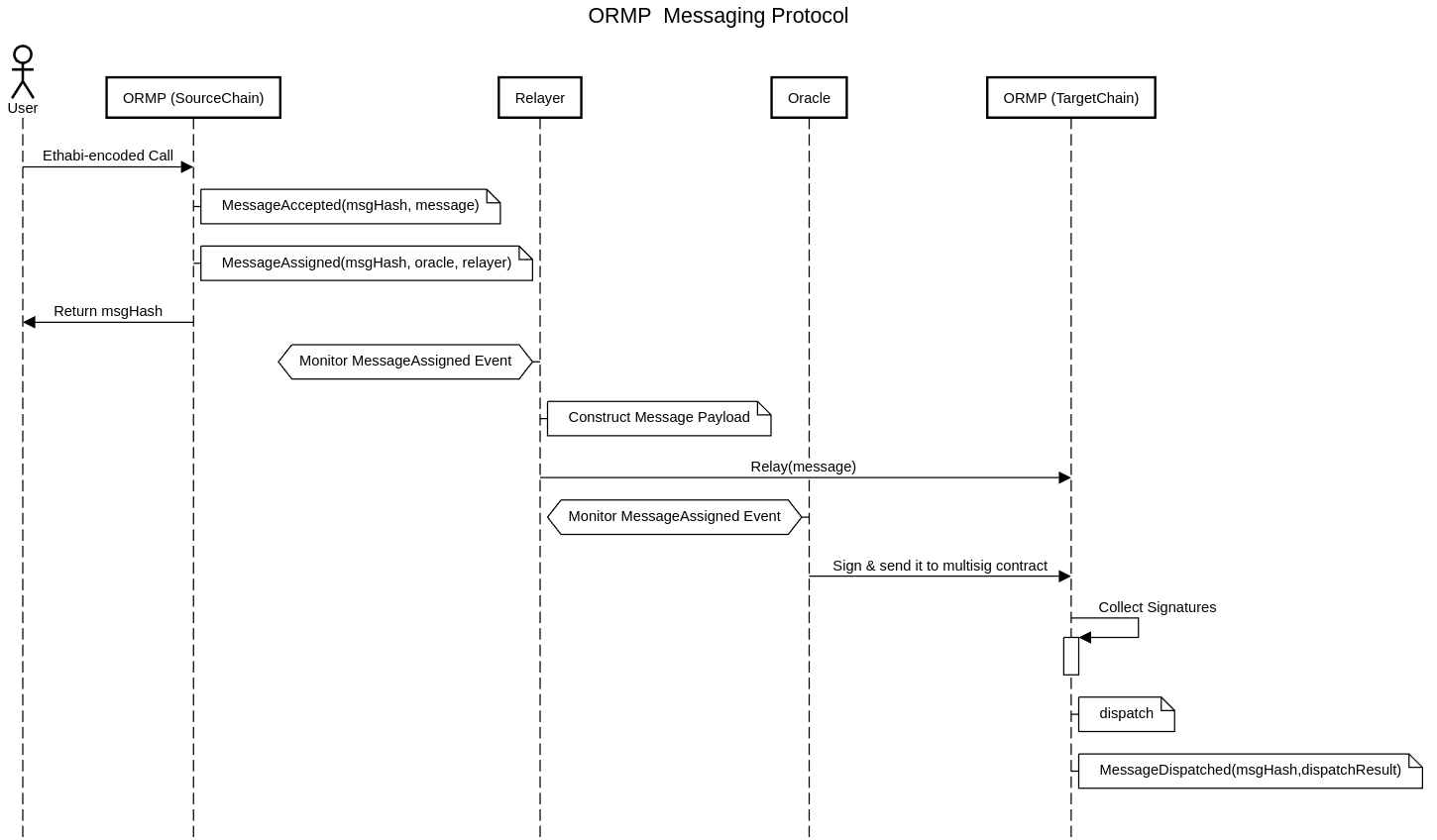ORMP Protocol¶
ORMP stands for Oracle Relayer Messaging Protocol. It is an omni-chain messaging protocol that can be used to build decentralized applications, or Dapps, that operate across multiple blockchains with minimal effort for developers. It's named after the two important roles involved in message cross-chaining:
-
The Oracle
In this context refers to any source of credible off-chain data. In ORMP, this data refers specifically to the hash of cross-chain message, we refer to this as the
msgHash. The msgHash is used to verify the authenticity of the cross-chain messages. The Oracle can either be a traditional off-chain data service, or a data feed based on the light client. Both methods can be used to validate the message prior to execution. -
The Relayer
It’s an off-chain piece of software that's responsible for taking messages from one blockchain and relaying them to another. It queries the source chain to find messages that have not yet been relayed, and then relays the message and its proof to the target chain. Once the target chain receives the message, along with the proof provided by the Oracle, the target channel can verify the authenticity of the message and process it further if it is found to be valid.
These two roles play a vital role in the entire process of sending, verifying, and receiving messages.
Highlight Features¶
- The cross-chain application provides the option to choose a different Oracle and Relayer if the user does not trust the ones provided by the official team.
- The protocol does not guarantee the ordering of messages. However, the application has the option to maintain a nonce or a unique identifier to ensure that messages are received in the correct order, if ordering is necessary. This allows for ordered delivery of messages, even if the protocol itself doesn't provide that guarantee.
Message Flow Design¶

Raw Message Structure¶
Cross-chain message passing involves wrapping the source data with additional information and transmitting it via a logic channel over the cross-chain network. The accurate structure of the Message to be transmitted is defined as follows:
Please be aware that the channel is tasked to store, receive and distribute messages, as well as overseeing the management of the message hash and its status.
Message Sending Flow¶
- The cross-chain application, built on the msgport interface IMessagePort, invokes the
send(from, toChainId, to, gasLimit, encoded_call)method of the ORMP. This method is a payable method, meaning it requires the payment of a specific fee to execute. The fee structure is further explained below. - Upon receiving the message, the ORMP contracts emit the
MessageAcceptedevent and return msgId to the sender as the an identifier for that message. - The ORMP contracts then invoke the specified relayer and oracle that have been previously registered with the protocol, emitting the
MessageAssignedto signal the start of their respective tasks.
Once these two steps are completed, the message sending process is considered finished.
Message Relaying Flow¶
The message relaying consists of two crucial roles: the relayer and the oracle service. These components continuously monitor the on-chain ORMP events to determine if there are new tasks assigned to them.
- When the relayer detects a new event, it retrieves the corresponding
MessageAcceptedevent and extracts detailed information about the message from the ORMP contract. It then invokes therelay(Message calldata message)method on the relayer contract on the target chain, completing the relay of the message payload. - When the oracle detects a new event, the oracle nodes fetch the corresponding
msgHashof the message. They sign themsgHashand send it to a specific multisig contract, which collects all the oracle node signatures. Once the multisig contract gathers enough signatures (typically ⅗), the oracle network triggers the setting of themsgHashto the oracle component in the ORMP contracts, completing the relay of themsgHash.
For the message to be executed in the ORMP target chain contracts, it requires both the message payload and a valid oracle msgHash.
Message Receiving Flow¶
When the relay method of the target chain contract is invoked, it performs the following validations:
- Verifies that the sender (relayer) is registered.
- Confirms that the message's
tofield matches the destinationchainId. - Checks whether the message has already been dispatched.
If the validation is successful, the message is then sent to the corresponding user application. Unless an exception occurs, the user contract's method is invoked to complete the cross-chain task associated with the message. At this point, we can consider the cross-chain message to have reached its destination.
Cross-chain Fee Calculation¶
The fee for cross-chain messaging is paid in the native token of the source chain. The application can retrieve the cross-chain fee by calling the fee function in the IMessagePort interface.
The total cross-chain fee consists of two parts: the oracle fee and the relayer fee. The oracle fee covers the cost of the oracle service. The relayer fee includes both the fee for relaying the message and the fee for executing the message on the target chain. If the fee paid exceeds the actual required fee, the excess amount will be refunded to the application.
OracleFee¶
The fee for an oracle on a specific chain is determined, see the fee page.
RelayerFee¶
The relayer fee is composed of the execution fee and the payload fee, with various factors influencing the calculation as detailed on the fee page.